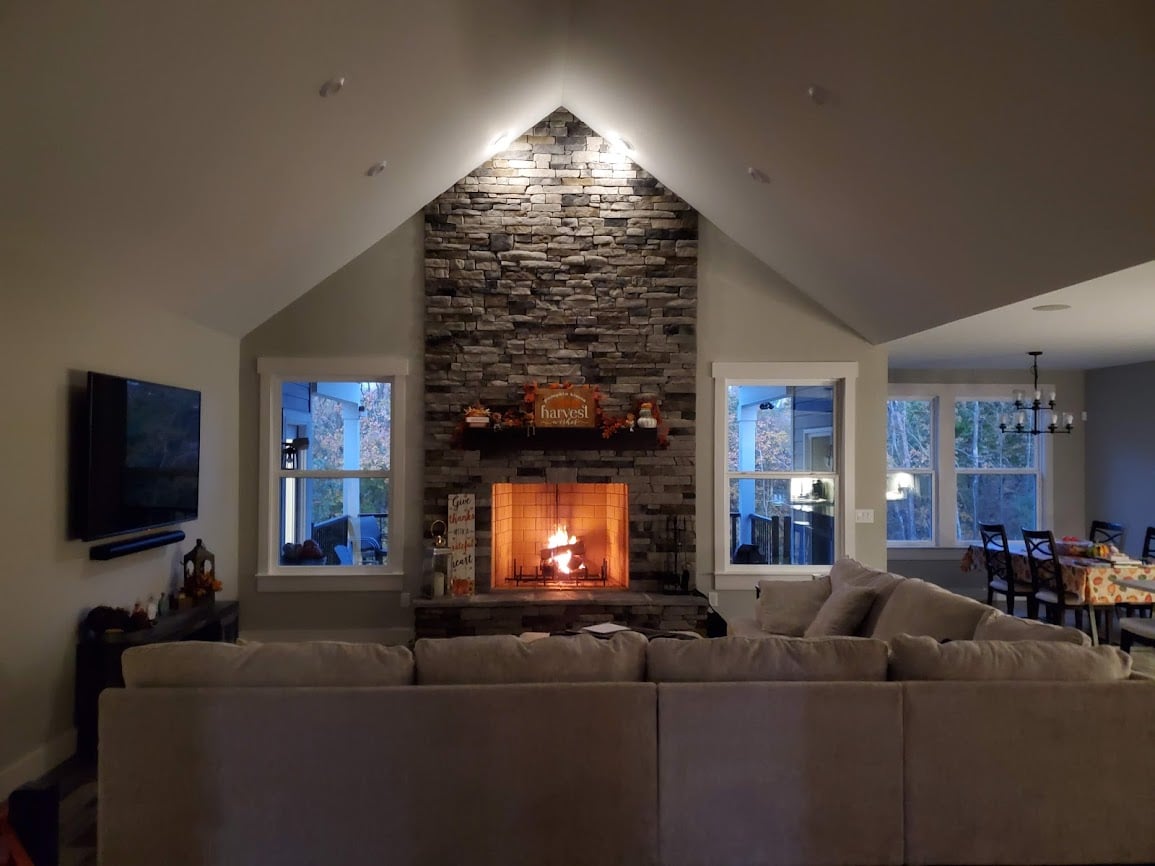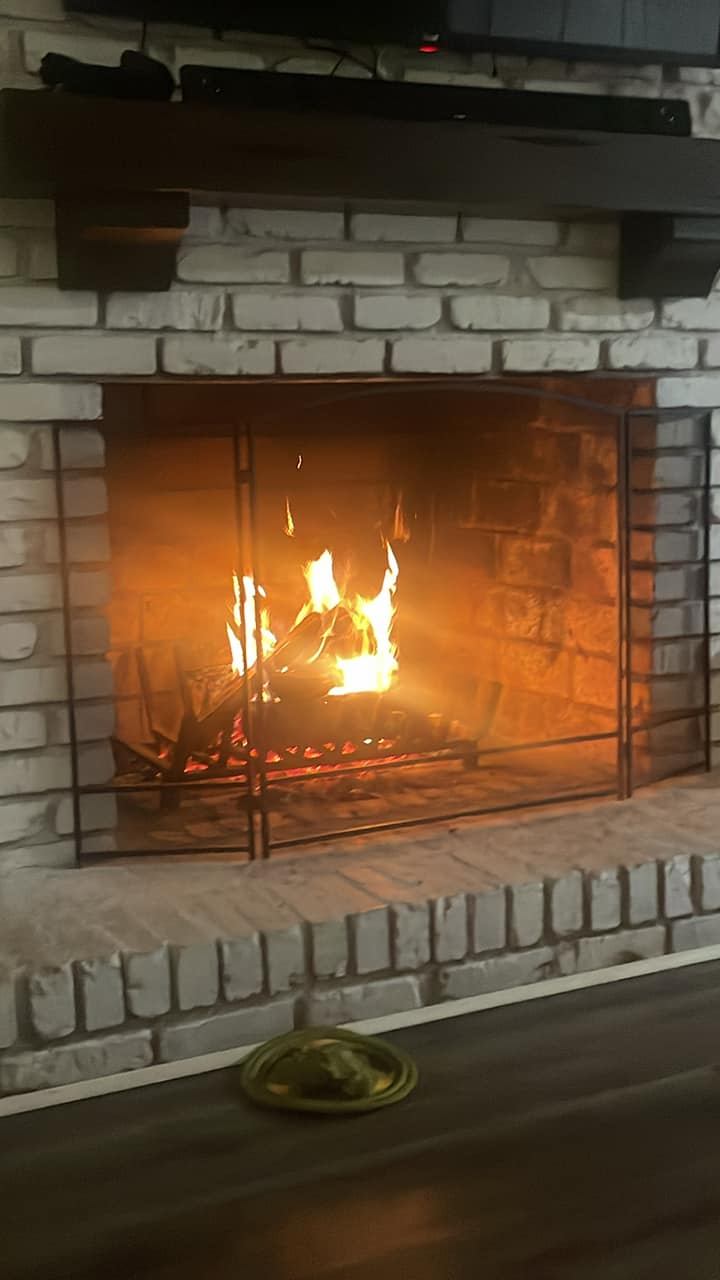A fireplace is undoubtedly a great addition to any home, but the caveat is the lingering, smoky odor. That’s not all; your fireplace could also develop a musty smell. We can all agree that a smelly fireplace is unpleasant, so addressing the problem is a priority.
An essential step towards having an odor-free fireplace is understanding the cause of the smells. After that, you’ll be able to tackle them successfully.
In this guide, we’ll dig into the common causes of a smelly fireplace and explore practical, effective steps to eliminate them and freshen your fireplace.
The Common Causes of Fireplace Smell
As mentioned above, identifying the cause of the odor is vital. Below are the common causes of a smelly fireplace.
a) Creosote Buildup
Before discussing how creosote causes fireplace odors, what exactly is creosote? It is a tar-like residue that forms in the chimney as a result of wood not burning completely. This substance will build up in the chimney with time, especially if you don’t clean it regularly.
Creosote has a noticeable smell that gets stronger when the weather is damp. Besides making your fireplace smelly, it can cause gases and smoke to re-enter the room by restricting the flue draught. Creosote is also toxic and can cause fires.
b) Soot Residue
Aside from creosote, an incomplete combustion of wood causes soot, a fine black powder that settles inside the fireplace. Soot has an unpleasant, smoky smell that increases in intensity during damp weather.
Related Posts:
- Best Fireplace Deodorizer
- Simple Outdoor Fireplace Ideas
- Fireplace Decor Ideas For Living Room
- Gas Fireplace Ideas For Living Room
c) Excess Moisture
If moisture gets trapped in the chimney or fireplace, it can cause a musty smell. Rain and snow will easily enter your fireplace if the chimney leaks or the crown or cap isn’t properly attached. Dampness facilitates mold growth, so be sure to fix this issue promptly.
d) Animal Residue
Animals nesting or sheltering in your chimney will inevitably leave their droppings and even carcasses behind should they die there, producing strong, offensive odors. In addition, animal droppings and nests can block the chimney, trapping smoke and gases inside.
Animals that commonly find their way into chimneys include chimney swifts (they nest in chimneys), squirrels, rodents, and raccoons.
e) Negative Air Pressure
If there’s a lower air pressure inside your house than outside, the difference can affect air quality and ventilation. For instance, instead of gases and smoke getting vented outside, they will be pulled back inside, causing unpleasant odors to linger.
This issue commonly affects homes equipped with modern ventilation systems like exhaust fans.
f) Tree Debris
If leaves, branches, flowers, and fruits accumulate inside your fireplace, they will eventually break down, emitting an earthy, musty odor. Seasonal leaf shedding, storms, and high winds increase the amount of tree debris that could get trapped in your chimney.
Related Posts:
- How to Stop a Fireplace Draft
- Telltale Signs It’s Time For A New Fireplace
- Signs Your Chimney and Fireplace Need Cleaning
How to Get Rid of Fireplace Smell
This section contains tactics to help you get rid of fireplace smells.
1. Clean The Fireplace Regularly
How well do you keep your fireplace? Set some time to clean it weekly if you use it regularly and at least every two months if you occasionally use it. You will remove soot, creosote, and debris as you clean your fireplace.
Air circulates better in a clean fireplace, so bad odors are less likely to linger. Moreover, a clean fireplace produces less fumes and smoke because of better airflow— this aids combustion.
Clean your fireplace when it is cool. Here’s what to do:
- Remove ashes and debris with a shovel or vacuum( the best vacuum for fireplace).
- Clean the fireplace with water and scrub.
- Remove any obstructions in the chimney.
- Scrub the chimney’s inside with a chimney brush in a bottom-up or top-down motion to remove creosote and soot. Alternatively, use a creosote remover with trisodium phosphate. Consider seeking professional cleaning, especially to remove a thick, glazed creosote.
2. Close The Damper
Drafts can bring unpleasant odors from outside or inside the chimney inside the house. Avoid this by closing the damper when the fireplace isn’t in use, but wait until the fire is fully extinguished and the embers cool down.
Besides helping prevent odors, closing the damper keeps warm air from your house from escaping through the chimney, thus improving your home’s energy efficiency.
However, open the damper before using the fireplace again to let gases and smoke vent safely outside.
3. Close The Fireplace Door
If your fireplace has a door, close it to contain the smokey odor produced when wood burns. It will also prevent drafts. Consider installing a door if your fireplace doesn’t have one.
4. Install a Chimney Cap
If your fireplace doesn’t have a chimney cap, it would be best to install it to ensure bugs, tree debris, and animals do not enter your fireplace. It will also keep moisture and rain out and prevent downdrafts.
Choose a chimney cap fitted with galvanized or stainless steel mesh screening to keep out even small debris without restricting airflow. Also, examine the condition of your chimney cap often. Make any replacements or repairs needed.
5. Cut Tree Branches Near The Chimney
We’ve established that odors can emanate from tree debris accumulating inside the chimney. But there’s more. Overhanging branches are also a fire hazard as sparks from your fireplace can travel up, thus igniting them.
Moreover, branches rubbing against or falling on the chimney can cause structural damage. For these reasons, cut any tree branches hanging close to your chimney.
6. Seal Cracks
Cracks in your fireplace walls, flue, or chimney will let odors enter your home. In addition, it will allow moisture to seep through, causing any metal components to rust, compromising the masonry, and providing a conducive environment for mold growth.
Inspect your fireplace’s interior and exterior parts for cracks and fix them. Depending on where the cracks or gaps are, repair the damage with mortar, caulk, crown sealer, silicone sealant, or crack filler.
7. Use The Right Firewood
The firewood you use in your fireplace will significantly impact the odors it produces, cleanliness, and efficiency. For instance, some types of wood create more smoke and exacerbate creosote buildup than others.
Only burn seasoned wood in your fireplace because it produces less smoke than unseasoned wood. Also, opt for hardwoods like oak, hickory, maple, and cherry over softwoods since they burn longer and hotter. Softwoods also produce less resin, meaning fewer odors and less creosote accumulation.
Avoid resinous wood such as pine because it emits a large amount of soot. This wood works splendidly as kindling, though.
8. Neutralize The Smells With Baking Soda
Baking soda, a mild alkaline, neutralizes odor-causing molecules. Sprinkle baking soda generously inside the firebox, leave it for a couple of days, then sweep or vacuum it. Alternatively, place a small open bowl with baking soda inside the fireplace. Do not use the fireplace until you take out the baking soda.
Combine the baking soda with essential oil for a pleasant aroma.
9. Use Vinegar
Vinegar doubles as a cleaner and odor-neutralizer. As a cleaner, it will make cleaning your fireplace much easier and produce excellent results since it eliminates soot, grease, and grime. It will also combat odors from your fireplace by dismantling the compounds responsible for them.
Place a bowl with white vinegar inside the firebox and let this mild acid absorb the odors overnight. Freshen up the air by adding essential oil to the vinegar.
10. Put Charcoal Inside The Firebox
Charcoal neutralizes odors and purifies air. Although regular charcoal briquettes, you are better off using activated charcoal (available in powder, pellet, or block form) because it is more effective. Buy activated charcoal at a garden center, pet store, online, or improvement store.
Put the charcoal in mesh bags, sachets, or tiny open containers and place them inside the firebox.
11. Use A Fireplace Deodorizer
Invest in a high-quality deodorizer for your fireplace to help you neutralize odors. These products are formulated to absorb unpleasant smells not mask them. Fireplace deodorizers come in spray, liquid, and powder form.
12. Get An Air Purifier
Place an air purifier with a HEPA filter a few feet away from the fireplace and let it do its magic. Make sure your chosen air purifier doesn’t produce ozone.
An air purifier will filter out odors and particles such as smoke, ash, and dust from your fireplace, making the area fresher and cleaner.
Final Remarks
Don’t let unpleasant smells from the fireplace turn your living spaces into areas you would rather avoid instead of one to retreat to unwind after a long day. Diagnose the problem and adopt the strategies outlined in this guide to eliminate those smells before they ruin your entire home’s ambiance.

Hi! I’m Susie, the creative mind behind Cozy Castle 101. I love sharing easy and simple ideas to make home and garden spaces cozy and inviting. From simple DIY projects and fun crafts to family-friendly recipes, I’m all about creating a warm, welcoming home where memories are made. Join me as I explore ways to add a bit of creativity and charm to everyday life!


